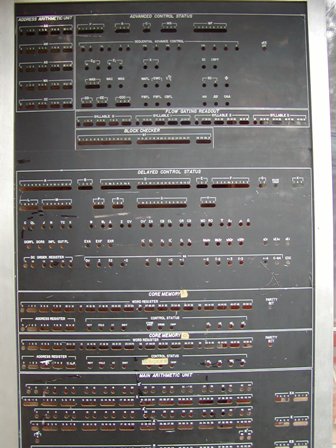
ILLIAC II
Encyclopedia


University of Illinois at Urbana-Champaign
The University of Illinois at Urbana–Champaign is a large public research-intensive university in the state of Illinois, United States. It is the flagship campus of the University of Illinois system...
that became operational in 1962.
Description
The concept, proposed in 1958, pioneered Emitter-coupled logicEmitter-coupled logic
In electronics, emitter-coupled logic , is a logic family that achieves high speed by using an overdriven BJT differential amplifier with single-ended input, whose emitter current is limited to avoid the slow saturation region of transistor operation....
(ECL) circuitry, pipelining, and transistor memory with a design goal of 100x speedup compared to ILLIAC I
ILLIAC I
The ILLIAC I , a pioneering computer built in 1952 by the University of Illinois, was the first computer built and owned entirely by a US educational institution, Manchester University UK having built Manchester Mark 1 in 1948.ILLIAC I was based on the Institute for Advanced Study Von Neumann...
.
ILLIAC II had 8192 words of core memory, backed up by 65,536 words of storage on magnetic drums. The core memory access time was 1.8 to 2 µs. The magnetic drum access time was 7 µs. A "fast buffer" was also provided for storage of short loops and intermediate results (similar in concept to what is now called cache
Cache
In computer engineering, a cache is a component that transparently stores data so that future requests for that data can be served faster. The data that is stored within a cache might be values that have been computed earlier or duplicates of original values that are stored elsewhere...
). The "fast buffer" access time was 0.25 µs.
The word size was 52 bits.
Floating point
Floating point
In computing, floating point describes a method of representing real numbers in a way that can support a wide range of values. Numbers are, in general, represented approximately to a fixed number of significant digits and scaled using an exponent. The base for the scaling is normally 2, 10 or 16...
numbers used a format with 7 bits of exponent (power of 4) and 45 bits of mantissa.
Instruction
Instruction set
An instruction set, or instruction set architecture , is the part of the computer architecture related to programming, including the native data types, instructions, registers, addressing modes, memory architecture, interrupt and exception handling, and external I/O...
s were either 26 bits or 13 bits long, allowing packing of up to 4 instructions per memory word.
Innovation
- The ILLIAC II was one of the first transistorized computersTransistor computerA transistor computer is a computer which uses discrete transistors instead of vacuum tubes. The "first generation" of electronic computers used vacuum tubes, which generated large amounts of heat, were bulky, and were unreliable. A "second generation" of computers, through the late 1950s and...
. Like the IBM StretchIBM 7030The IBM 7030, also known as Stretch, was IBM's first transistorized supercomputer. The first one was delivered to Los Alamos National Laboratory in 1961....
computer, ILLIAC II was designed using "future transistors" that had not yet been invented. - The ILLIAC II project was proposed before, and competed with IBM's Stretch project, and several ILLIAC designers felt that Stretch borrowed many of its ideas from ILLIAC II, whose design and documentation were published openly as University of Illinois Tech Reports.
- The ILLIAC II had a division unit designed by faculty member James E. Robertson, a co-inventor of the SRT Division algorithmDivision (digital)Several algorithms exist to perform division in digital designs. These algorithms fall into two main categories: slow division and fast division. Slow division algorithms produce one digit of the final quotient per iteration. Examples of slow division include restoring, non-performing restoring,...
. - The ILLIAC II was one of the first pipelined computers, along with IBM's Stretch Computer. The pipelined control was designed by faculty member Donald B. GilliesDonald B. GilliesDonald Bruce Gillies was a Canadian mathematician and computer scientist, known for his work in game theory, computer design, and minicomputer programming environments.- Education :...
. The pipeline stages were named Advanced Control, Delayed Control, and Interplay. - The ILLIAC II was the first computer to incorporate Speed-Independent CircuitryAsynchronous circuitAn asynchronous circuit is a circuit in which the parts are largely autonomous. They are not governed by a clock circuit or global clock signal, but instead need only wait for the signals that indicate completion of instructions and operations. These signals are specified by simple data transfer...
, invented by faculty member David E. Muller. Speed-Independent Circuitry is a class of asynchronous digital logic based on the Muller C-elementC-elementThe Muller C-element, or Muller C-gate, is a commonly used asynchronous logic component originally designed by David E. Muller. It applies logical operations on the inputs and has hysteresis. The output of the C-element reflects the inputs when the states of all inputs match. The output then...
. This digital logic, being asynchronous, runs at full speed of transistor propagation and requires no clocks.
Discoveries
During check-out of the ILLIAC II, before it became fully operational, faculty member Donald B. GilliesDonald B. Gillies
Donald Bruce Gillies was a Canadian mathematician and computer scientist, known for his work in game theory, computer design, and minicomputer programming environments.- Education :...
programmed ILLIAC II to search for mersenne prime numbers
Mersenne prime
In mathematics, a Mersenne number, named after Marin Mersenne , is a positive integer that is one less than a power of two: M_p=2^p-1.\,...
. The computer found 3 new prime numbers. The results were immortalized for more than a decade on a UIUC Postal Annex cancellation stamp, and were discussed in the New York Times, recorded in the Guinness Book of World Records, and described in a journal paper in Mathematics of Computation.
End of life
The ILLIAC II computer was disassembled roughly a decade after its construction. By this time the hundreds of modules were obsolete scrap; many faculty members took components home to keep. Donald B. Gillies kept 12 (mostly control) modules. His family donated 10 of these modules and the front panel to the University of Illinois CS department in 2006.Donald W. Gillies, the son of Donald B. Gillies, has a complete set of documentation (instruction set, design reports, research reports, and grant progress reports, roughly 2000 pages) from the ILLIAC II project. He can be contacted for further details about this computer. Most of this documentation should also be available as DCL technical reports in the UIUC Engineering library, although it would not be packaged as a single report.
External links
- Gillies, Donald B. Three New Mersenne Primes and a Statistical Theory, Mathematics of Comput., Vol. 18:85 (Jan. 1964), pp. 93–97.
- ILLIAC II documentation at bitsavers.org

